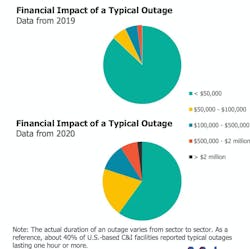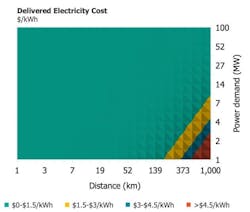When businesses and industries — especially industries such as mines — are located more than 62 miles from grid connections and require less than 20 MW of power, on-site generation and microgrids make more sense than purchasing from the grid.
Financial impacts of outages, courtesy Lux Research
That’s just one of four scenarios identified by Lux Research in a new report, The Future Role of On-Site Power Generation, that looks at reasons businesses and industries might want to embrace on-site power generation.
Worries about power outages and reliability are a second reason companies are becoming more interested in on-site power. In fact, such concerns have prompted clean energy companies and state energy officials to ask the federal Department of Energy to help coordinate efforts to create energy resilience, with, among other technologies, microgrids.
A third scenario in the Lux Research report looks at how on-site generation — including electric boilers — can be used to provide power to industrial processes, leading to more efficient use of energy.
And a fourth scenario focuses on facilities — such as wastewater treatment plants — that generate “nontradable byproducts.” On-site generation can help make the byproducts more valuable by using them as fuel.
The report points out that decarbonization and decentralization of power have increased the use of residential on-site power, with homeowners installing rooftop solar and behind-the-meter batteries.
Why businesses are embracing on-site power
Just as important, businesses are embracing on-site generation.
According to the report, “… On-site generation has seen adoption in commercial and industrial facilities facing issues related to grid capacity, energy security, process integration and production of nontradable byproducts.”
For example, the need for low-cost and reliable electricity has boosted the business case for on-site generation in off-grid mining sites and pulp and paper mills, the report said.
Decarbonizing the industrial sector will lead to electrification and will spur an increase in electricity consumption as electricity becomes the main energy option in the future. The report cited the Shell Sky Scenario, which said that electricity consumption in light industries will jump by a factor of three in the next 30 years. The Shell Sky Scenario predicted decentralized solar systems will increasingly be used to meet this need.
The Lux Research report also pointed out challenges to getting more distributed energy resources (DER) online, among them high upfront costs.
Revenue streams offset costs
But taking advantage of multiple revenue streams can make DERs more cost effective, the report said.
As an example, the report pointed to Enchanted Rock’s gas-powered microgrids that provide backup generation and grid services.
Recently, Enchanted Rock developed a 3.5-MW microgrid to provide resiliency for a butene manufacturing plant in Baytown, Texas.
In this case, the company is using a resilience-as-a-service model called Integrated Reliability on Call. When the manufacturing plant doesn’t need the backup generation, Enchanted Rock will sell power from the generators into the Electricity Reliability Council of Texas’ wholesale power markets to reap revenue, which reduces the cost to customers such as the butene manufacturing plant.
Another way businesses and industries can boost the cost-effectiveness of on-site generation investments is to evaluate the company’s load along with its distance to the closest interconnection point on the grid.
The sweet spot is a business or facility that is located more than 62 miles from grid connections, with an energy requirement of less than 20 MW of power, according to the report.
By Parilov/Shutterstock.com
When microgrids make sense for mines
For example, on-site power for remote mining operations can be more cost-effective than electricity from a faraway grid connection point because they meet the sweet spot requirements. Remote mining operations’ loads tend to be less than 20 MW.
Diesel generators have been a main choice for mines because of their low cost: Their installation costs are about $1/watt, and they can attain levelized cost of electricity values as low as $0.15/kWh, according to the report.
“However, renewable energy alternatives like solar-plus-storage systems are becoming an increasingly competitive option to displace diesel and decarbonize off-grid mines,” the report said.
“Mining is an important focus because of its energy intensity. As of 2020, the mining sector accounts for about 38% of global industrial energy use,” the report said. Energy-related expenses in mines represent about 30% of the total operating costs.
Some clean energy companies have begun offering on-site systems to address the need for clean power in mining efforts.
For example, a Hitachi ABB microgrid system is greening mining operations and providing continuous power for off-grid mining operations at Indo Tambangraya Megah’s facility in Bontang, East Kalimantan in Indonesia.
“All in all, mining is a dynamic sector facing issues like difficult operating conditions, constraints around energy availability, and potential impact of volatile fossil fuel prices – all of which creates an opportunity for decentralized power production,” the report said.
Electricity costs vs. distance from grid, courtesy Lux Research
Others who benefit from on-site power
Another promising scenario for on-site power is using electric boilers for light industries.
Farming and food and textile production need low-to-medium temperature heat streams — below 500 degrees. On-site power can serve this need with electric boilers.
In addition to electric boilers, industries could benefit from innovative methods to store heat and optimize heat transfer, including thermal energy storage systems which can provide dispatchable heat. That can increase flexibility and unlock new revenue streams, said Lux.
Another scenario that favors on-site energy is using on-site generation that takes advantage of industrial byproducts.
One example is a microgrid at a wastewater treatment plant in Rialto, a city east of Los Angeles, California.
Instead of flaring biogas at the plant, the biogas will be used to help fuel a cogeneration facility that will also provide heat for the plant’s anaerobic digesters.
The planned system will avoid the use of natural gas. First, natural gas will no longer be mixed with the biogas to burn it off. Second, the natural gas that now heats the anaerobic digesters will no longer be necessary because the biogas will be used.
Overall, on-site power generation can kick-start decarbonization efforts in many industries, including mining and food production, as well as facilities that need higher levels of energy security.
“Innovations like the rapid cost decrease of distributed generation and batteries, high-temperature thermal energy storage, and VPP [virtual power plant] systems to aggregate local backup power to provide grid services will improve the business case for on-site generation and thus spur further deployment,” the report said.
Track news about microgrids for mines. Subscribe to the free Microgrid Knowledge Newsletter.











